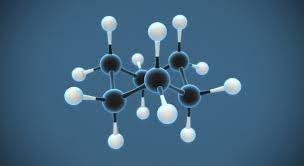hydrocarbon
A hydrocarbon is an organic compound composed of only carbon and hydrogen.
Division
Traditionally, hydrocarbons are divided into groups according to the type of bonds between atoms or whether their basic carbon chain is open (acyclic) or closed (cyclic).
According to the type of bonds
aliphatic (does not contain a benzene ring)
saturated: alkanes, cycloalkanes,
unsaturated with double bonds: alkenes, cycloalkenes, dienes and polyenes,
unsaturated with triple bonds: alkynes, cycloalkynes,
aromatic (arenes) (containing at least one benzene nucleus).
Cyclic aliphatic hydrocarbons are called alicyclic (cycloaliphatic).
The simplest hydrocarbon is methane, a hydrocarbon with one carbon atom and four hydrogen atoms: CH4. Ethane is a hydrocarbon (more precisely an alkane) consisting of two carbon atoms connected by a single bond, each with three hydrogen atoms: C2H6. Propane has three carbon atoms (C3H8) and butane has four (C4H10). Next comes pentane (5), hexane (6), heptane (7), octane (8), nonane (9), decane (10), undecane (11) and dodecane (12). This homologous series continues and differs by the homologous addition CH2, so the general formula of alkanes is CnH2n+2.
Hydrocarbons and derivatives
There are three types of hydrocarbon nomenclature: trivial, which is the oldest and is related to the place of occurrence or properties, functional group (radically functional), which consists of the hydrocarbon residue and the name of the functional group, and systematic, defined by the IUPAC organization.
The chemical name of hydrocarbons can consist of prefixes, a stem indicating the number of carbons, and an ending. Prefixes can be numerical (di, tri, tetra, ...) or nominal (cyclo- for a closed chain, iso- and neo- for a branched chain, alkyl- for bound hydrocarbon residues). A more diverse set of prefixes include hydrocarbon derivatives to denote functional groups. The base word denoting the number of carbons is either trivial (meth-, eth-) or based on a numeral. The ending expresses a chemical bond (-ane, -ene, -diene, -yne) or a hydrocarbon residue (-yl). Other endings for functional groups occur in hydrocarbon derivatives.
When creating the name of hydrocarbons, it is first necessary to find the longest carbon chain with the largest possible number of multiple bonds. Then the carbon atom is numbered to produce the smallest number possible.
A double bond takes precedence over a triple bond and over a hydrocarbon residue. The prefixes of hydrocarbon residues with their position number follow their name in alphabetical order. The endings denoting the type of binding are arranged similarly. For branched hydrocarbons containing the group (CH3)2CH- at the end of the chain, the prefix iso- can be used, for the group (CH3)3C- the prefix neo-.

